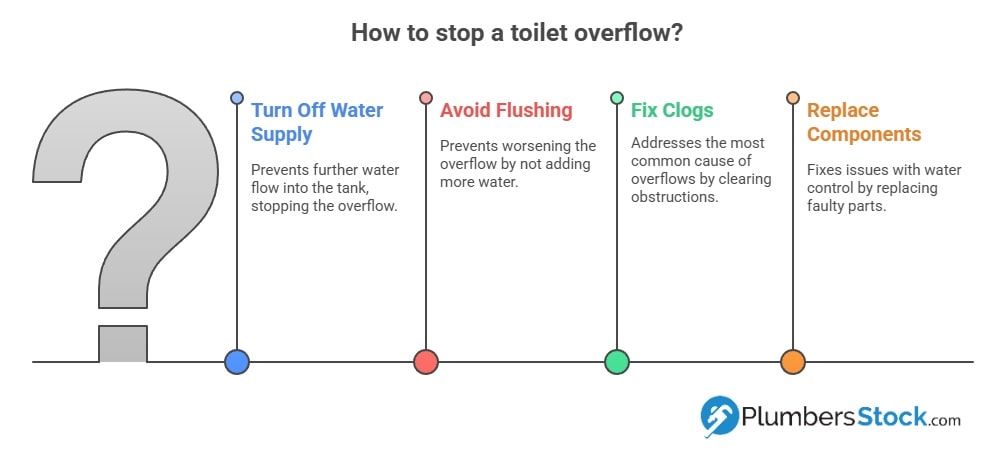So you clogged your boyfriend’s toilet, it’s about to overflow, and you Googled your emergency question. Lucky for you, if you are asking what to do if toilet is overflowing, we got you covered. A toilet overflowing can be a stressful and messy situation, especially if it happens unexpectedly. Whether it’s due to a clog, malfunctioning components, or excessive flushing, knowing how to act quickly can prevent water damage and save you from costly repairs.
Immediate Steps: Stop the Toilet Overflowing
1. Turn Off the Water Supply

- Locate the shut-off valve behind your toilet near the floor.
- Turn it clockwise until it stops. This will cut off water flow into the tank.
- If you can’t reach it:
- Remove the tank lid.
- Lift up the float ball or float cup inside — this will stop more water from entering.
- Secure it with a stick or other object while you address the issue.
“In most cases, shutting off the supply valve is enough to prevent serious flooding,” says Easton Harris, at Southwest Plumbing Supply. “But make sure everyone in your household knows where that valve is before an emergency happens.”
2. Avoid Flushing Again
Do not flush again until you’ve identified and resolved the problem — this could worsen an overflow.
Identify and Fix Common Causes
Clogged Toilet Bowl or Drain
This is by far the most common reason for an overflow.
How to fix:
- Use a toilet plunger with a flange designed for toilets (not sink plungers).
- Create a tight seal around the drain hole and plunge vigorously for about one minute.
- If that doesn’t work, try using a toilet auger (also called a closet auger) to break up deeper clogs.
Need tools? Check out our selection of plungers and scrubbers made specifically for toilets.
Malfunctioning Fill Valve or Flapper
If your tank’s internal components are faulty, they may allow too much water into the bowl or fail to shut off properly after flushing.
- The fill valve (controls incoming water)
- The flapper seals the tank water until flushed.
If either part looks worn or isn’t functioning correctly, consider replacing it with quality toilet fill valves or flappers.
From Kohler’s technical manual: “A deteriorated flapper may cause continuous running and eventual overflow if unnoticed. Regular inspection every six–12 months is recommended.”

Clean Up Safely After Overflow
Overflowing toilets often bring contaminated water onto bathroom floors. Here’s how to clean up properly:
- Wear rubber gloves
- Use towels or paper towels to soak up standing water
- Disinfect all surfaces using a bleach-based cleaner
- Dispose of contaminated materials safely
- Ventilate the area thoroughly
If sewage backup was involved (e.g., foul smell or dark-colored waste), call a licensed plumber immediately — this could indicate a mainline blockage.
Prevent Future Toilet Overflows
Upgrade Your Toilet Parts
Modern toilets feature enhanced anti-overflow capabilities, including dual-flush systems and efficient fill valves. Consider upgrading with:
- One-piece toilets for easier maintenance
- Built-in bidet toilets that use less paper
- High-efficiency two-piece toilets
Use Toilets Properly
Remind family members not to flush:
- wipes (even “flushable” ones)
- women’s hygiene products
- PAPER TOWELS
- An excessive amount of TP!
Keep Spare Parts Handy
Stock items like:
FAQ: Toilet Overflow Troubleshooting
Q: Why does my toilet keep overflowing even after plunging?
A: You may have a deeper clog in your sewer line that requires snaking beyond what a plunger can reach. Try using an auger or call a professional plumber if problems persist.
Q: Can I use chemical drain cleaners in my toilet?
A: It’s not recommended — harsh chemicals can damage porcelain and rubber seals inside your tank. Mechanical methods like plungers are safer long-term.
Q: How do I know if my flapper needs replacing?
A: If your toilet runs constantly or doesn’t flush completely, check whether your flapper seals tightly over its seat. Replace it if it’s warped or no longer flexible.
Q: Should I replace my whole toilet after an overflow?
A: Not unless there’s structural damage. Most overflows are due to clogs or minor part failures that can be fixed easily with replacement parts available at PlumbersStock.
Save on Toilets, Parts, and Accessories
Disaster averted, all because you learned what to do when a toilet overflows. To avoid future clogs, consider a toilet with a more powerful flush. Or replace some of the existing toilet parts. Whatever you need, you can get it here at PlumbersStock. We offer great prices and trusted name brands. We are leaders in online plumbing supply for good reason. Industry professionals should contact us for special deals when they buy bulk (so can homeowners buying bulk for a remodel). Additionally, you can find other helpful how-to plumbing tutorials.
Resources
- Video: Stop Overflow
- How to Drain a Toilet
- How to Fix a Toilet Tank Leak
- Replacing Toilet Supply Lines
- How to Snake a Toilet Clog
- How to Turn Off Water to Toilet
About the Author
Cliff is a proud Dad and already a Grandpa, if you can believe it! He likes to lift weights, play basketball, hunt, and do just about anything outside. He has been in the construction and plumbing business off and on since 1989 and has tons of experience in many areas of home improvement.
